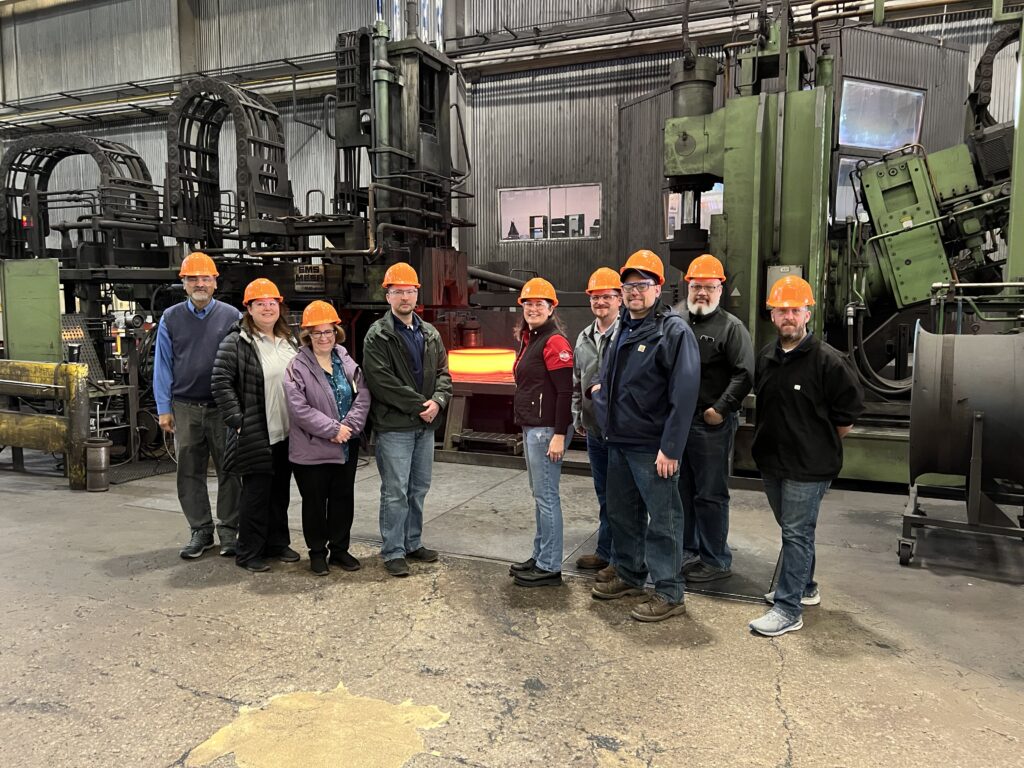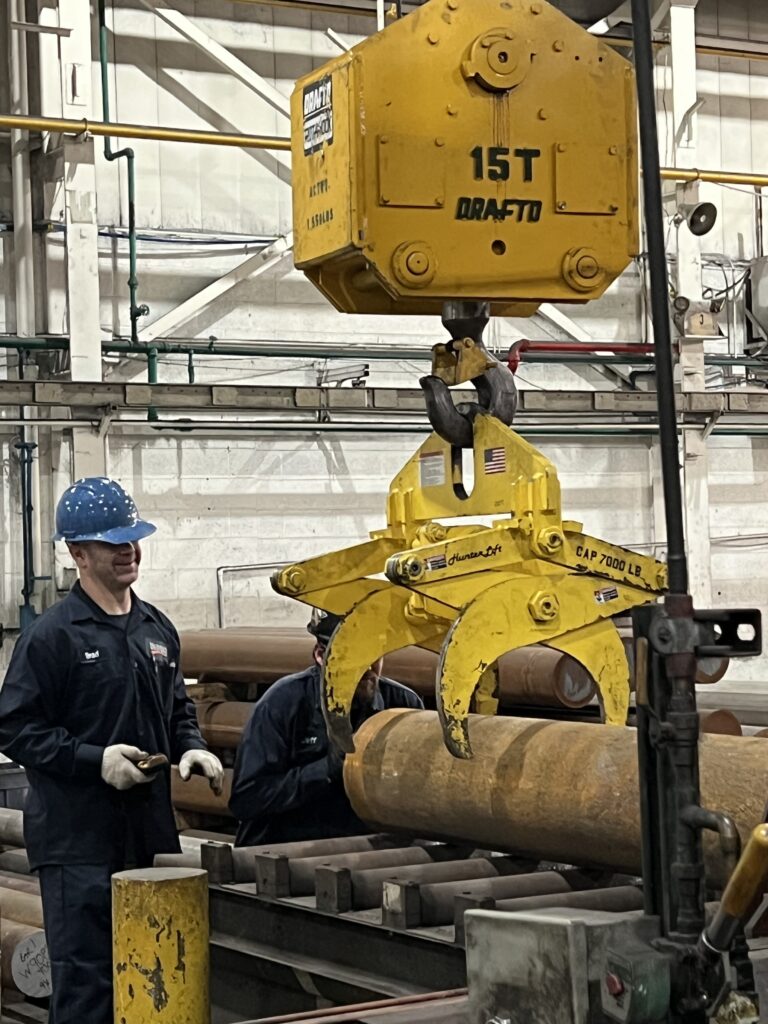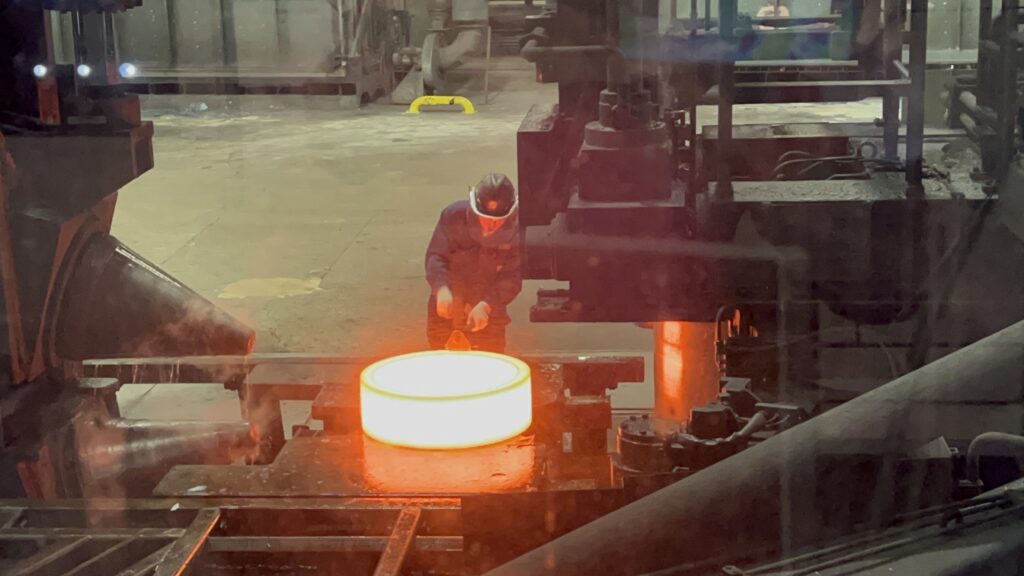By Margaret Slattery
(March 07, 2024) “Remember Goldilocks—not too fast, not too slow, just right. You ready?” That’s Dr. Bob Voigt, a Materials Science and Engineering professor at Penn State University, coaching me on my first casting experience.
I’m wearing a reflective silver suit from head to toe, high-temperature gloves, and a face shield. Minutes before, I’d been scooping sand around polystyrene, lifting the flask with an overhead crane, and peering into molten Aluminum 356 that looks like mercury that escaped from a giant thermometer. As Bob tilts the induction furnace, I catch a stream of liquid metal in the ladle.
In a process called lost foam casting, the metal instantly vaporizes the Styrofoam mold and fills in the impression for a custom stein. Ten seconds is all it takes.
This is the world of casting, an industry that walks the line between traditional art and modern science.

Casting and Forging 101
My career up until now as a television producer gave me some pretty cool opportunities, including working with Mike Rowe in the precursor to Dirty Jobs, but I’ll get back to that. If someone gives me the chance to try something new—especially if it scares me a little—I jump right in. Now that IACMI is working on a new workforce initiative called METAL (Metallurgical Engineering Trades Apprenticeship & Learning), I’m pushing aside my fears of spilling thousand-degree metal to understand why this is a career worth pursuing.
For five days, I’m traveling from one end of Pennsylvania to the other, trying to get beyond what I’ve gleaned about casting and forging (C&F) from pop culture. I’m getting a diverse taste–from companies that produce critical assets for the U.S. Department of Defense (DoD) to school foundries giving hands-on training.
So, here’s a brief overview of C&F from the novice perspective. In casting, you heat metal to melting and then pour it into the shape you want, like melted chocolate into heart-shaped molds. In forging, you heat metal until it’s soft enough to change its shape with pressure. Most of us picture the blacksmith pounding a piece of steel with a hammer. Forges today have much, much bigger tools.

The Dance – The Choreography of Forging and Casting
During a visit to ELLWOOD National Forge (ENF), a family-owned group of businesses that evolved over a century, I’m fascinated by a massive forging press. Two men communicate by hand signals through double panes of heat-resistant safety glass to mold a tall, 3-ton cylinder of steel into a squattier disc to precise specifications. The “manipulator” holds and adjusts 1,800-degree glowing steel with huge claws from what looks like a forklift. The “driver” wields two joysticks and foot pedals to operate the pounding press to get just the shape and size he needs. For 30 minutes, they change the shape and strength of this steel over and over in a sort of dance of small adjustments and repetitive motions, calculating input on five different monitors. The next day at an ELLWOOD Group Inc. property, McInnes Rolled Rings, I watch them work even faster, turning a smaller, solid donut of steel into rings of all kinds of sizes in minutes. It’s mesmerizing.
I witness a similar choreography at Effort Foundry, which has customized 10,000+ casted patterns. You know an employee’s role and experience level from the color of the hard hat. Four blue hats and one white hat create a bucket brigade of sand to pack enormous forms. Once the sand is firm enough and the imprint of the shape they need is intact, they don silver suits just like I wore and take turns, each performing a unique task with exact timing. When it comes to pouring metal, seconds matter.

Embracing the Dark, Dirty and Dangerous Work of Casting and Forging
When you see this amazing industry in action, you wonder why people aren’t lining up to be part of it. Early on I learned that may be because of their reputation of the 3D’s: dark, dirty, and dangerous.
Dark: Yes, foundries are generally dark, at least compared to the bright light of molten metal. Aside from some opaque windows that may be towards the top of a building and a few strategic fluorescent lights, most foundries are darker than any office building. This isn’t surprising since many are working on classified, national security type projects. Also, windows could be a liability with that kind of heat. That said, LED lighting is making a big impact for many C&F companies.
Dirty: Yes, I see a fair number of dirt floors, spilled sand, and metal remnants throughout the foundries I visit. Like most of metal manufacturing, they create dirt, work through dirt, and take dirty scrap and make it into clean products. Again and again, I hear, “Dirty doesn’t bother me.”
Dangerous: Yes, it’s a workplace that requires you to be vigilant. Speedy forklift drivers, sharp materials to maneuver, the occasional molten donut that drops and rolls on the shop floor. There’s no room for distraction. However, foundries handle dangerous things using safe practices. “Safety rules are your best tools” and “Keep safety in mind. It will save your behind” are quippy reminders hanging throughout. The companies I visited track and showcase how many days– sometimes years – they’ve been incident-free.
And some would add another D: dead-end, the myth that these are narrowly focused jobs instead of careers. Before coming to a foundry, I thought maybe we should just gloss over the 3 or 4Ds. But after seeing it all in person, I realize how wrong that would be. The people who choose casting or forging aren’t afraid of tough work or getting dirty. They embrace it. They wear it like a badge of honor in careers that are far from dead-end.
For instance, the technical director and metallurgist for ENF was showing me his new work boots. As he checked in with his team members, someone noticed the shiny leather and quickly smudged them with whatever dirt was on the bottom of his shoes. He wasn’t upset. Boots are meant to reflect work– strenuous work that has and continues to build what our country needs.
That’s something I learned working with Mike Rowe about 20 years ago. Maybe you’ve heard of him. He authentically respected and wanted to celebrate the many jobs that require getting dirt under your fingernails and sweat on your brow. They were proud of their dirty jobs—a theme I find in casting and forging.

Patriotism & Automation in the Casting and Forging Careers
For this group of men and women, there’s another driving force: patriotism. For those working on defense contracts, they’re creating components that keep our warfighters safe. Many of them are even veterans seeing this as their next way to serve. They work with the mindset that they must get it right. Mistakes could mean wasting precious materials, but even more importantly: time. There’s a widening gap between the products our military needs and the people skilled to make them. This year alone the C&F industry will need an additional 1,000 engineers and 25,000+ skilled trades positions. We need more people who take that same pride in the part they’re casting or forging. It’s not just a part that goes in a tank, a jet, a ship, or a submarine. Someone’s life could depend on them doing their job right.
Another appealing aspect of C&F is the current and future technology supporting the industry. At Effort Foundry, I met four engineers working on Computer Aided Designs (CAD) and simulations showing exactly how the metal will flow into the cavity.
“It’s a great combination of math and creativity,” comments one young lady.
At McInnes they’re using robotic arms and claws with overhead cranes to move materials with ease. ENF is using automation in finishing. What used to require 12 employees now only needs four. But robots aren’t taking their jobs. Most are even getting promotions to do more challenging tasks. ELLWOOD Group Inc. boasts that no one has been laid off in 20 years. Automation is focused on those repetitive or tedious tasks that no one wanted to do in the first place. It’s pretty cool now, but so much more is on the horizon.
Why Advanced Manufacturing
I’ve seen first-hand that manufacturing is far from what I initially pictured of assembly lines and button pushers. Whether it be CNC machining, 3D printing, casting, or forging, that’s simply not the reality of advanced manufacturing. It’s critical thinking—how can I make this part more efficiently, saving time, materials, and cost? It’s problem solving—iterating a scenario or sequence again and again until you have a reliable, consistent solution. It’s exploring new innovations and technologies, walking that line between traditional art and modern science.
These are all the reasons I share optimism in the rejuvenation of manufacturing in this country, and why I’d be proud to see my children build their own paths in it. Two of my kids have already taken America’s Cutting Edge (ACE) training for CNC and are lining up summer jobs in manufacturing. Would they consider working in a foundry? That’s up to them. My job as a storyteller—and yes, as their mom—is to show them what’s possible. To give them access to experiences that could shape their career trajectory and the tools to give them choices. That’s why I’m so excited to see all the different “on and off ramps” that IACMI is developing for METAL: 3-hour workshops for middle and high schoolers, 5-day bootcamps for ages 18+, online courses, internships, apprenticeships, direct trades training, and college degree certifications. Stressing safe conditions, we’re letting them experience how fun pouring metal can be. Our goal goes beyond educating; we’re here to inspire.

Once my stein has cooled and we bead blast off the rough finish, I’m filled with the satisfaction that comes from knowing “I made that.” The possibilities of making other things are endless. We all want to leave our mark on the world—to point to something we did or wrote or made. We’re all creators at heart. So, no matter how dark or dirty or dangerous your workspace may be, I say embrace it! We honor you for choosing a hard day’s work and encourage others to Melt Boundaries and Mold Futures. Who’s ready?
Margaret Slattery is communications manager for IACMI-The Composites Institute, a Manufacturing USA Institute established by the U.S. Department of Energy. A mother of three, Margaret has a passion for storytelling and American manufacturing.
ABOUT METAL
The METAL program aims to transform the U.S. metal manufacturing workforce in the casting and forging industry by developing a set of stackable curriculums from K to gray through a national training network. An industry-led initiative supported by DoD’s Industrial Base Analysis and Sustainment Program and in partnership with the Institute for Advanced Composites Manufacturing Innovation (IACMI), METAL aims to close the skills gap in the U.S. base metals industry. METAL is addressing the workforce shortage through apprenticeships, certifications, and degree programs. It will leverage IACMI’s proven workforce development capabilities, including the successful America’s Cutting Edge (ACE) program for CNC machining training. Learn more at MetalforAmerica.org
